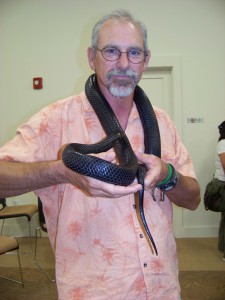Over the last few weeks, I have received several questions and comments on, and about, the eastern indigo snake. I was curious as to why so many in such a short time – maybe a public television program on them or something? Not sure, but it is an amazing snake and I like to talk about them. So, let’s talk about them.
The eastern indigo (Drymarchon couperi) is the longest native snake found in North America. It reaches a length of 9 feet and can weigh up to 11 pounds. It is beautiful. A shiny, iridescent black, with smooth scales that give a glossy look and emits beautiful patterns of color when the sun reflects off it that resembles the sheen you see when gasoline is spilled on water. This beautiful coloration, being nonvenomous, and docile attitude made it very popular as a pet – except that it can reach up to 9 feet long.

Their habitat of choice are high sandy ridges along the extreme southeastern United States. These ridges are covered with longleaf pine or turkey oak trees and provide enough space, hibernacula, and food to support them. Though a point of origin has not been published, the historic range suggest a possible origin in Florida. It has been suggested that there were once two distinct genetic forms of indigo snakes, one existing along the Gulf coast and another along the Atlantic coast. It appears there was a climatic barrier separating the two which no longer exist and today it is believed that there is only one species in existence now. The historic range of the snake included extreme southwest Mississippi, extreme coastal Alabama, extreme coastal Georgia, and all of Florida. The most recent range shows the snake exists across the entire Florida peninsula and some portions of southern Georgia but does not include all of Georgia’s historic range. It may be extirpated in the Florida panhandle, with a few rare reports, and believed to be completely extirpated in southern Alabama and Mississippi.
Indigos live mainly solitary lives with large home ranges that can extend hundreds to thousands of acres. Males have larger home ranges than females. Indigo snakes are diurnal and forage for their food rather than sit and ambush as many snakes do. Their diet consists of a variety of species, but diet studies show that rodents, frogs, small turtles, and snakes make up the bulk of their prey. It also includes species of venomous snakes like the eastern diamondback and copperhead.
Indigo snakes move between upland and lowland habitats during the warmer months. During the winter months they are closely associated with gopher tortoise burrows where the temperature can range between 45F and 88F and average 54F. They often emerge on sunny winter days to bask but do not move too far from the burrow. It is not known how long indigos live in the wild, but they have lived as long as 25 years in captivity.
During the 20th century the population of these snakes began to decrease. As is often the case, the loss of suitable habitat was a big problem. Longleaf pine forests where no prescribed burning was occurring as frequently as they had historically, the understory altered the habitat to a point where indigos could not support themselves. This also led to the decrease in gopher tortoise populations along with their burrows in which the indigos needed. The harvest of gopher tortoises as food and pets also decreased the number of burrows and thus the number of snakes. Often people would pour gasoline into the burrows to get the tortoises out and this led to the death of many indigos. And then there was the collection of the snakes for the pet trade. Another problem was that they are snakes. An eight-foot snake crawling around had little chance of escaping the wrath of scared humans.

Today they are completely missing in Mississippi, Alabama, and the Florida panhandle. They are listed as an endangered species under the Endangered Species Act, and there are attempts to restore their populations in Alabama and the eastern Florida panhandle. Though there are occasional reports from the panhandle, there have been no verified records of the eastern indigo in the western panhandle since 1999. We would like to see this animal return but to do so, the habitat will need to be restored, and head starting (releasing captive bred snakes) may be needed as well. Though they are large, they are harmless to humans and actually provide a needed service by controlling the populations of venomous snakes in our region. I for one would love to see them return.
- St. Joe Red Tide Claiming Terrapins - December 15, 2025
- The 2025 Snake Watch Report for the Pensacola Bay Area - December 15, 2025
- Rattlesnakes on Our Barrier Islands; Part 2 – Prey Selection - December 15, 2025
